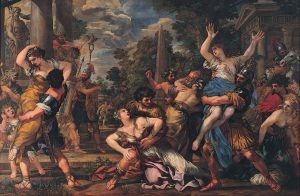by Maniza Naqvi
 I write this as Saturday begins to wane on the long Columbus Day weekend while I listen on the radio to the speeches given by senator after senator prior to the final confirmation vote for Bret Kavanaugh as Associate Justice on the Supreme Court of the United States of America. The vote is scheduled for 3.30 p.m. October 6, 2016. I listen to their conflicted words in the Senate of the United States pleading yes or no, or yes and no. Conjuring images, I am reminded of that Roman mythology and the artists’ rendition of it, of the Rape of the Sabine Women.
I write this as Saturday begins to wane on the long Columbus Day weekend while I listen on the radio to the speeches given by senator after senator prior to the final confirmation vote for Bret Kavanaugh as Associate Justice on the Supreme Court of the United States of America. The vote is scheduled for 3.30 p.m. October 6, 2016. I listen to their conflicted words in the Senate of the United States pleading yes or no, or yes and no. Conjuring images, I am reminded of that Roman mythology and the artists’ rendition of it, of the Rape of the Sabine Women.
The idea and basis of the State is illustrated by artists through a rendition of this mythology for its first founding. The idea of State as we know it is based on this concept and definition of family and marriage in which there are unequal members: some to be served and others to serve; some to consume while others to produce; some to own and others to be owned; some to rule and others to be ruled; some to be strong and continuously strengthened by all means necessary and others to be weak and be weakened by all means necessary. All this a must for the good of the State—and the spirit vested into it through this definition of family.
The sum of the few define for the total. Some. And all the others. There must be a trinity, the strong, the weak and the thing—that volition, that psyche that justifies it. It is this unspeakable immorality and violence that forms the basis of our beliefs of piety and morality vested then into the concept of State.
It is thus through the violence done to the weakest, usually women and those indigenous to the place arrived at or later migrants, that the State demonstrates its unique sovereignty to be able to do whatever it wishes—The State demonstrates and vests into itself the power and ability to do violence on the weak and thus defines its strength and its self. And that is what it is.
This idea is encapsulated in the Roman mythology known as the Rape of the Sabine Women. The word rape comes from the Latin word “raptio” which scholars and historians interpret as a word mean kidnapping and abduction and not sexual assault. No doubt most of these historians and scholars are probably not women.
Artists and sculptors have illustrated these views in times when it would have been heresy and blasphemy to have done so. Their art as only art can do leaves it to our interpretation what history is about and what all of this means about the rules that govern us. For rules, which ever they are whether they are religious or secular, have been made by men and women who mimic them and so both terms, religious and secular mean the same for the business of states. It is Greek and Roman mythology that guides both. And their men and women got to be gods. But the rulers and makers of rules were men.
Romulus along with his twin brother were raised by wolves. Romulus as the story goes much like Cane and Able, kills Remus. And the idea of pack of wolves, a wolf pack is really just another name for a family of wolves. The leaders of the pack are called the alpha male and female. These two animals are dominant over all the other wolves in the pack. The alpha male and female are the only wolves that breed and produce pups in the pack, and they also get to eat first at kills. There may be a reason why elite fraternities and sororities at colleges and universities in America are named for Greek letters Alpha beta this Alpha Pheta that.
 The Rape of the Sabine Women was an incident in Roman mythology in which the men of Rome led by Romulus the twin reared by wolves committed a mass abduction of young women from the other cities in the region. The History of the Romans as written in the 1st century BC by the historian Titus Livius Patavinius, or Livy as he was known, tells us how ancient Rome was founded in 753 BC by Romulus and his male followers.
The Rape of the Sabine Women was an incident in Roman mythology in which the men of Rome led by Romulus the twin reared by wolves committed a mass abduction of young women from the other cities in the region. The History of the Romans as written in the 1st century BC by the historian Titus Livius Patavinius, or Livy as he was known, tells us how ancient Rome was founded in 753 BC by Romulus and his male followers.
Romulus and his men had founded the nation of Rome and they could easily have lived happily ever after murdering each other if needed but there could be no future for Rome if there were no children. These Romulus’s Romans needed to have women to produce sons and girls to produce more sons.
A solution was found in the next village over. They went over to the village which had women and invited the Sabines to a party. Lots of food and lots of drink. After copious amounts of both of much feasting and boozing they made their suggestion to the Sabines: we’re here to get your young women,
When the women refused the Romans took them against their will and the will of their men. Simply took them. I say simply because violence and plunder was pretty straight forward and simple. Banal. The Sabine women were abducted and against their wills made to produce Romans. This was the Rape of the Sabine women. (here and here)
Of the Sabine women, the Roman historian Livy writes as translated by Henry Smith Williams: “They, from the outrage on whom the war originated, with hair dishevelled and garments rent, the timidity of their sex being overcome by such dreadful scenes, had the courage to throw themselves amid the flying weapons, and making a rush across, to part the incensed armies, and assuage their fury; imploring their fathers on the one side, their husbands on the other, “that as fathers-in-law and sons-in-law they would not contaminate each other with impious blood, nor stain their offspring with parricide, the one their grandchildren, the other their children. If you are dissatisfied with the affinity between you, if with our marriages, turn your resentment against us; we are the cause of war, we of wounds and of bloodshed to our husbands and parents. It were better that we perish than live widowed or fatherless without one or other of you.” (here)
As the final vote for the confirmation of Bret Kavanaugh as Associate Justice to the Supreme Court proceeded—the overwhelming sounds during the roll call for Senators as it was called out to vote, was not the yes or the no of each but instead the anguished and panicked screams of “STOP” by women in the galleries, STOP, STOP, resounding through the Senate Chamber and reverberating far beyond—preserved and unheeded through the past and into the future.
